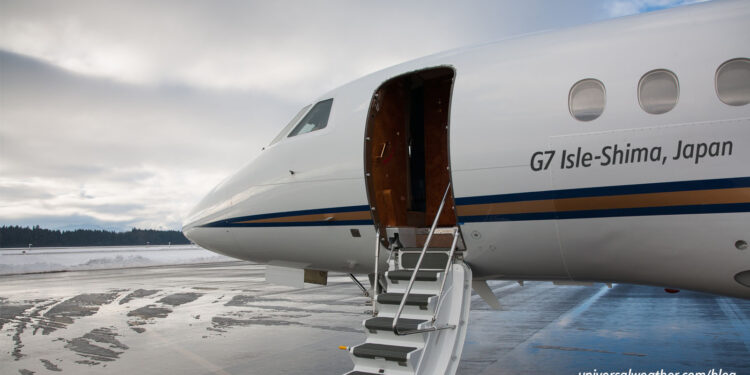BizAv Trip Planning: G7 Japan Summit 2016 – Part 2: Operating Considerations

This is a post by author Hiroshi Higashiyama. Hiroshi is representative director for Universal Aviation Japan, which has aircraft ground handling facilities in Haneda, Narita, Sapporo, and Osaka. Hiroshi is an expert on business aircraft operations in Japan and can be contacted at hiroshihigashiyama@universalaviation.aero.
This business aviation blog post continues from our article last week, titled “BizAv Trip Planning: G7 Japan Summit 2016 – Part 1: Airport Options.”
In addition to what was covered in our last article, business aircraft operators flying into Japan during the G7 Summit period also need to be aware of possible permit requirements, the customs, immigration, and quarantine (CIQ) process for their preferred airport, and some general high-traffic event pre-planning considerations.
The following is an overview of what you need to know:
1. Permit requirements for Japan
Landing permits are needed for charter (non-scheduled commercial) operations. Official permit lead time is three business days, but permits can often be obtained within 24 hours, at the discretion of the Japan Civil Aviation Bureau (JCAB). Documentation needed with permit requests includes:
- charter agreement
- air operator certificate (AOC)
- certificates of registration and airworthiness
- worldwide insurance
- noise certificate
- crew licenses and medicals
- TCAS II certificate
- power of attorney (so that your handler may file the permit request)
Permits are valid for a single flight and only for the day approved. Permit revisions are generally accomplished the same day and in most cases do not entail additional documentation submissions.
Private non-revenue operators require a landing permit when commencing domestic operations. A permit request, which must be in Japanese, is sent to JCAB via mail or in person, as regulations don’t permit fax or email. The normal lead time is three business days, but short notice requests and emergency flights processed within 24 hours at JCAB’s discretion.
2. CIQ clearance and passports
For diplomatic flights landing at Chubu Centrair (RJGG) and Nagoya (RJNA), it’s anticipated that passengers will clear CIQ onboard. On the other hand, crew will clear within the terminal. CIQ clearance at Osaka (RJBB) is in the main terminal, and the complete process, from deplaning to clearing CIQ, generally takes about 10/15 minutes as there is a dedicated fast lane available for GA aircraft. In the case of Shizuoka (RJNS), passengers and crew will clear in the main terminal, a 15-20 minute process, unless scheduled commercial flights are arriving at the same time.
For the Tokyo airports—Narita (RJAA) and Haneda (RJTT) – VIP clearance options are available for an additional charge. If passengers and crew choose to clear via the main terminal at RJAA, they’ll clear in the same lines as commercial passengers, and this process can take one-to-two hours, depending on the traffic. In the case of RJTT, passengers/crew opting not to use VIP clearance options will have a long walk to the CIQ clearance area in the main terminal, but passengers will be able to clear via the crew line. Passports are needed for all passengers and crew visiting Japan and only need to be valid for length of stay.
3. Traveling with pets
We recommend that passengers do not travel with pets when visiting Japan for the G7 Summit, even for those with diplomatic passports and access. If you land in Japan with a pet, it will be taken to a quarantine facility for a 60-day stay, and not all pets survive this process.
4. Hotel options
For those who do not already have accommodations arranged, crew hotel options in the Nagoya area will be extremely limited. You’ll not likely be able to find 4- or even 3-star accommodations as virtually all rooms over the G7 Summit period have been pre-booked. For crew staying in the Osaka area, high quality hotel accommodations should be available. Typical pricing for 4-star crew accommodation ranges from 300 – 500 USD/night.
5. Local transport
At this time most prepaid (car with driver) transport options in the Nagoya area have already been reserved. However, trains and public taxis are available and are safe travel options for both local travel and longer commutes. Rental cars may also be considered for crew familiar with the local area. Keep in mind that you’ll be driving on the left side of the road, and most road signage will be in Japanese.
Conclusion
Aircraft parking and crew accommodations are trip planning challenges that need to be addressed as early as possible for those attending the G7 Summit. Be mindful that sourcing adequate crew accommodation options close to the Summit venue, in the Nagoya area, will be particularly difficult. Also, permits may be required for your flight, so it’s best to allow appropriate time to obtain needed approvals. To ensure that everything goes smoothly, it’s best to work closely with your 3rd-party provider or local ground handler.
Questions?
If you have any questions about this article or would like assistance planning your next trip to Japan, contact me at hiroshihigashiyama@universalaviation.aero.




